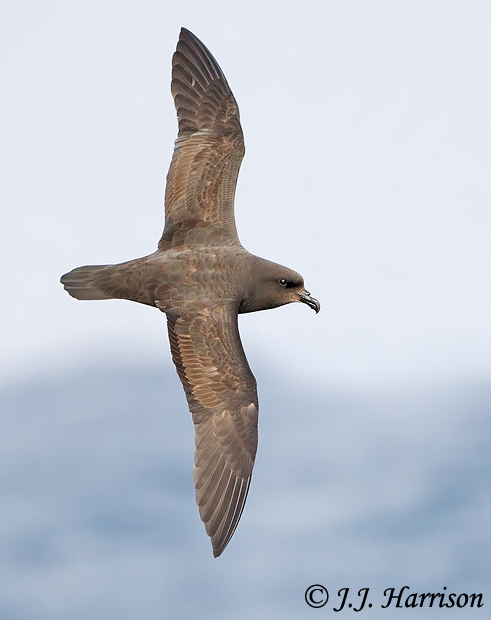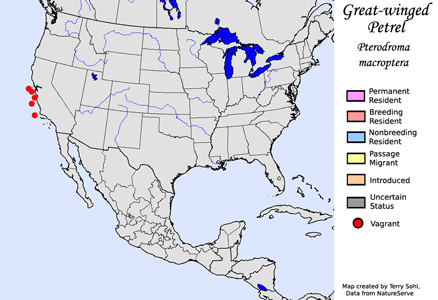Great-winged Petrel
Pterodroma macroptera
| Length: 15.5 inches | Wingspan: 36 inches | Seasonality: Non-resident in South Dakota |
| ID Keys: Dark brown plumage overall, black bill, lighter colored plumage near base of bill | ||
 The
Great-winged Petrel, also known as the Gray-faced Petrel, is a seabird of
the far southern oceans. They breed in scattered locations throughout
the southern oceans, from the coasts of southern Australia and northern New
Zealand, to islands in the south Atlantic and Indian Oceans.
Non-breeding birds wander throughout the southern hemisphere, but they have
occasionally been found in the northern hemisphere as well. North
American records consist of a handful of sightings off the coast of
California.
The
Great-winged Petrel, also known as the Gray-faced Petrel, is a seabird of
the far southern oceans. They breed in scattered locations throughout
the southern oceans, from the coasts of southern Australia and northern New
Zealand, to islands in the south Atlantic and Indian Oceans.
Non-breeding birds wander throughout the southern hemisphere, but they have
occasionally been found in the northern hemisphere as well. North
American records consist of a handful of sightings off the coast of
California.
Habitat: Found in scattered areas in the southern oceans during the breeding season, using coastline ridges and scattered island groups as nesting colonies. Pelagic at other times of the year.
Diet: Feeds mostly on squid, but will also take small fish and crustaceans.
Behavior: Soars over the ocean's surface, dipping down to grab prey items from the ocean's surface or just below.
Nesting: Nesting typically occurs near the base of a small shrub or other plant, or between tree roots. A single egg is laid, with an incubation period of about 8 weeks. Both parents help feed and tend to the young after hatching.
Song: Has a high-pitched, shrieking call.
Migration: Many birds are found near nesting colonies even outside of the breeding season, but others wander widely across the southern oceans.
Interactive eBird map: Click here to access an interactive eBird map of Great-winged Petrel sightings
Similar Species: Similar to several shearwater species, including Sooty Shearwater, Flesh-footed Shearwater, and Short-tailed Shearwater.
Conservation Status: There are indications that global populations are decreasing, but at this time there are no serious threats to the species. The IUCN lists the Great-winged Petrel as a species of "Least Concern".
Further Information: 1) BirdLife International - Great-winged Petrel
2) Planet of Birds - Great-winged Petrel
3) WhatBird - Great-winged Petrel
Photo Information: Photo taken by J.J. Harrison - May 27th, 2012 - Near Tasmania - Licensed under Creative Commons Attribution ShareAlike 3.0 Unported License
| Click below for a higher-resolution mapClick below for a higher-resolution map |
 |
| South Dakota Status: Non-resident in South Dakota |
Additional Great-winged Petrel Photos (coming soon!!)
